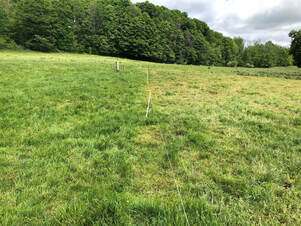CONSERVATION CORNER
A weekly blog for all things conservation
 By: Nathan Dewing, Agricultural Team Leader, Bradford County Conservation District Grazing season has arrived which means farmers and animals alike kick their heels in glee! Supplemental feeding in the pasture, barn, or barnyard is expensive, labor intensive and stressful, so all are relieved to see the animals get out onto green pastures again. Grazers, what is one step you can take this year to make your operation more efficient or productive? This is a good way to think about it. When you think about all the things you want to do, you may get overwhelmed and stuck. Selecting ONE allows progress. Let me suggest one to get you thinking. Typical pastures in Bradford County may yield 1 – 2 ton of dry matter per acre, when that same acre is capable of 4 or 5 ton in a year. Certainly, many factors contribute to this inefficiency, but perhaps one rises to the top. Let’s take a closer look at overgrazing.
The best definition for overgrazing is re-grazing too soon. The most common thought is to define it as grazing grasses too short, but it is more accurate to say that short grasses are what overgrazing leads to. When livestock enter a field, they start munching away at the lush green goodness. During their first trip around the field they may eat the top 40% or 50% of the plant. When they make their second trip, they’ll nip it down a little further. By the end of the week the plants they like are chewed right down to a couple inches above the soil. Overgrazing happens with the second trip around the pasture. Grasses have energy reserves ready to re-grow the plant when it is cut. If we can manage the amount of grass the livestock remove, those energy reserves can go to work for us. When moisture is adequate a crop that is 50% grazed may be ready to graze again in two weeks. That same crop grazed down to 20% may take 4-6 weeks to recover. When livestock graze down into the plant’s energy reserves, re-growth slows, and overall yield is reduced significantly. Three days is a key time frame to consider. If just three day’s-worth of regrowth is immediately re-grazed, that plant’s yield potential is significantly reduced. Shockingly, what happens underground is even more important than what we see above. What you see above ground, will be proportional to what you find underground. Think like this: tall plants, big roots. Short plants, small roots. This really is what happens. It may be obvious that a larger root system will give the plant more access to soil moisture and nutrients. But the less obvious root functions are even more fascinating and powerful. Roots release chemical signals into the soil that stimulate the soil critters to do their work. Soil organisms ranging in size from microscopic bacteria to earth worms, are essential in making soil nutrients available to plants. Robust roots translate into more productive soils. When considering pasture management then, a farmer starts to think about plant re-growth. They begin to manage animals so that pastures can rest and re-grow before they are grazed again. That means they start to divide their grazing fields into sections. After grazing in section one livestock are moved to section two, and not allowed to circle back. Early in the year, section one may be ready for its second harvest in two weeks. During dryer summer months, it may rest six or eight weeks. A rule of thumb for grass management is “take half, leave half”. You may let livestock in when grass is 12 inches tall and take them out when it measures six inches. Improving re-growth may allow a field to be grazed five times in one year and could double current pasture yields. If you are grazing livestock on one big pasture all season, here is a suggestion for that one step to take this year. Divide the pasture up and move them to a new section each week. Try to do this without buying anything. Use what you have. Do it with temporary fence because you don’t know what fence layout is going to work best. If you must buy one thing, I suggest a roll of polywire, but I have a better idea - call us to borrow one! The conservation district has some temporary fence supplies to loan out to a farm experimenting with grazing management changes. Trying new things and doing them imperfectly will wake you up, and get your blood flowing again. Breathe deep, smile, kick your heels (figuratively if necessary), and take a step. The Bradford County Conservation District is committed to helping people manage resources wisely. You can visit the Bradford County Conservation District at 200 Lake Rd in Wysox across from the Wysox Fire Hall. Contact us at (570) 485-3144 or visit our web page at www.bccdpa.com.
0 Comments
Leave a Reply. |
AuthorsVarious staff at the Bradford County Conservation District Archives
April 2024
Categories
All
|
